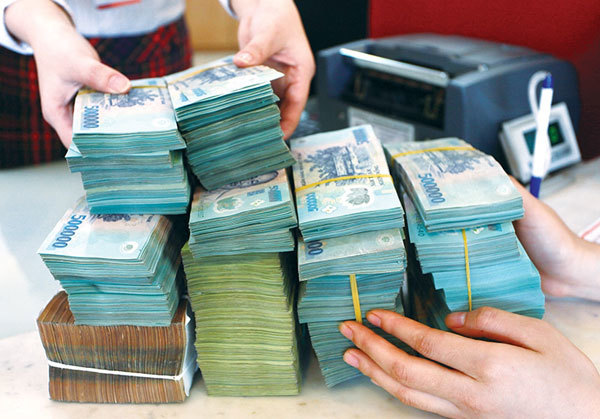 |
| Vietnam’s public debt in GDP stands at around 45.6 per cent. - VIR Photo: Le Toan |
National Assembly (NA) Chairman Vuong Dinh Hue said that there will be many changes in the laws and regulations on state budget management over the next governmental period.
“This is aimed to mobilise, allocate, manage, and use in a more effective manner all resources, with internal resources considered a fundamental and long-term strategy in combination with important external resources. All are in service of socioeconomic development, ensuring macroeconomic stability, boosting economic growth, and tackling social security issues,” said Chairman Hue. “We will continue restructuring the state budget and increasing stable revenue sources, while radically saving recurrent spending in order to increase development investment.”
The NA has released Resolution No.23/2021/QH15 on the national financial plan on borrowing and payment of public debt for the 2021-2025 period (see box).
In order to realise these targets, the NA will amend the Law on State Budget and relevant legal documents. Localities are encouraged to increase revenues and mobilise possible resources for their own development, and they are to take initiative and be responsible for their usage of the state budget.
In addition, “we will be prompt to revise and perfect a number of tax-related laws, especially those on VAT, corporate income tax, and special consumption tax,” and “pay more attention to revenues from land, natural resources, and minerals in order to shun losses.”
Notably, all regulations on tax incentives and priorities will be reviewed so as to avoid losses and ensure equality and transparency among investors.
Furthermore, there will be a reduction in recurrent spending which currently occupies about 70 per cent of total state budget expenditure and an increase in development investment.
All new loans as official development assistance and concessional loans from donors will be used only for development investment, not for recurrent spending.
“These loans will be earmarked only for a number of key economic sectors in order to ensure economic effectiveness, with investment used for projects that can directly help boost economic growth and sustainable development.”
Suitable answers
However, a number of NA members have said that in order to ensure sufficient resources for socioeconomic development until 2025, one of the key solutions will be fostering the development of the private sector including business households and private enterprises.
In Vietnam, the private sector creates up to 43 per cent of GDP, 49 per cent of total development investment, 15.4 per cent of state budget, and 85 per cent of total labourers, according to the Ministry of Planning and Investment (MPI).
“It is suggested the government soon enact more feasible solutions to help the private sector out of difficulties and attract more private investment for national development,” said deputy Do Thi Lan representing the north-eastern province Quang Ninh. “The sector’s strong development will result in more money contributed to the state coffers.”
MPI Minister Nguyen Chi Dung, also the NA deputy representing the central province of Quang Tri, noted that for the private sector to further develop and make bigger contributions to the country, “all hurdles must be eradicated, and all best conditions must be created. Enterprises and the public need a safer business climate.”
“If the private sector fails to receive further support, the country will be unable to reach high economic growth sustainably and hit the goals set in the Party’s resolution. Even the country will be unable to overcome the middle-income trap without contributions from the private sector, especially given that the state budget remains limited,” he said.
By late 2020, the public debt accounted for 55.2 per cent of GDP. Last year, the Vietnamese economy suffered from a total state budget deficit of $11.87 billion, with budget expenditure more than $77.39 billion, including recurrent spending of $42 billion or 54.2 per cent. Policies on deferred tax payments and directly supporting businesses and the public have also amounted to tens of billions of US dollars.
Debt obligations
For 2021, the government is set to borrow over $27.14 billion, which is made up of $22.93 billion from domestic sources and $4.21 billion from foreign lenders. Of this, about $25.2 billion will be used to balance the central budget while the remainder will be spent on lending. The government is expected to repay debts of around $17.15 billion in 2021.
Under Vietnam’s recently-approved public debt management programme for the 2021-2023 period, the total borrowing until 2023 will be $75.65 billion, of which $69.56 billion will go to the central budget. The local budget spending deficit is limited at 0.2 per cent of GDP, as stipulated in the 2015 Law on State Budget, and the debt repayment obligation of local governments is approximately $800 million.
With regards to foreign commercial loans by businesses and credit institutions, the growth rate for short-term credit is capped at 18-20 per cent, per year, and the net maximum medium-term and long-term loans are around $6.35-7 billion per year.
According to The Economist’s Global Debt Clock, by late last week, Vietnam’s public debt in GDP stood at 45.6 per cent, and per capita public debt was $1,450, while total public debt was almost $94.85 billion.
The Ministry of Finance reported that from January-July 15, the state budget expenditure hit $32.9 billion, of which around 71 per cent was recurrent spending. Other types of spending embraced development investment capital of $6.56 billion and interest payment of $2.7 billion. Meanwhile, the total state budget revenue hit $35.62 billion. In which domestic revenue totalled $28.78 billion, revenue from crude oil exports stood at $873.9 million, and revenue export-import activities sat at $5.94 billion. Thus, there was a surplus in the state budget of nearly $2.69 billion in the period.
|
National financial plan on borrowing and payment of public debt 2021-2025 - Total state budget revenue in the 2021-2025 period will be about VND8.3 quadrillion ($360.87 billion). The ratio of mobilised sums in GDP will be not lower than 16 per cent, in which money from taxes and fees will occupy 13-14 per cent of GDP, and the ratio of domestic revenue will be about 85-86 per cent of the total state budget revenue. - The total state budget spending will be as much as VND10.26 quadrillion (over $446 billion), of which 28 per cent will be used for development investment, and 62-63 per cent will be earmarked for recurrent expenditure. It is expected that efforts will be made to increase the ratio of development investment to 29 per cent and to reduce the ratio of recurrent spending to about 60 per cent. - The total spending for development investment from the state budget will be about VND2.87 quadrillion ($124.78 billion), including VND300 trillion ($13 billion) from foreign capital and VND248 trillion ($10.78 billion) from divestment and equitisation of state-owned enterprises. - The average rate of state budget overspending will be at 3.7 per cent of GDP. In which, the average deficit of the central budget will sit at 3.4 per cent of GDP, and that of localities’ coffers will stand at 0.3 per cent of GDP. It is expected that efforts will be made to reduce the average rate of state budget overspending for the period to less than 3.7 per cent of GDP. - The total loans in the 2021-2025 period will be over VND3 quadrillion ($130 billion), in which loans of the central budget will be valued at about VND2.9 quadrillion ($126 billion); the government’s direct debt payment will be about 1.7 quadrillion ($73.9 billion); localities’ total loans will be as much as VND148 trillion ($6.43 billion); and localities’ debt payment will be about VND35.3 trillion ($1.53 billion). - The country’s annual public debt ceiling will not exceed 60 per cent of GDP, with the warning level of 55 per cent of GDP. The government’s annual debt limit will not surpass 50 per cent, with the warning level of 45 per cent. The national foreign debt annually will be not over 50 per cent of GDP, with a warning level of 45 per cent of GDP. |
Source: VIR

Production shoring up state coffers
Although the state budget revenue was dented in May due to the resurgence of COVID-19 affecting businesses’ performances, the first five months of the year have seen a big surplus in the state coffers,

Debt under control thanks to prudent and effective actions
Effective usage of the state budget has helped Vietnam succeed in bringing public debt under control since 2016, ensuring national financial security.